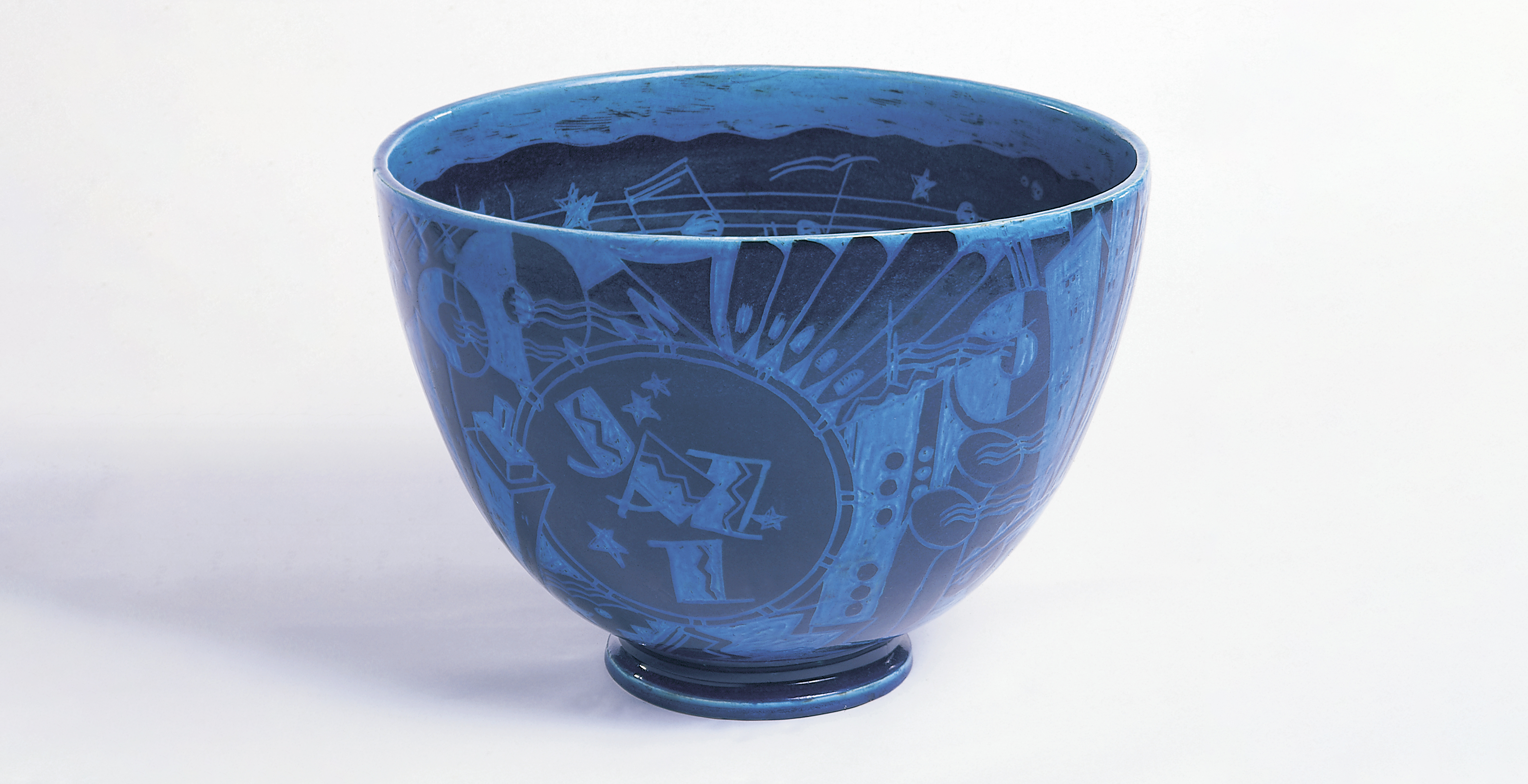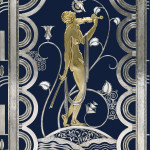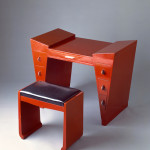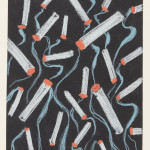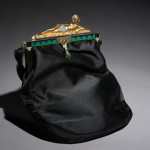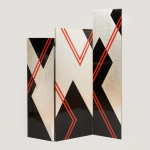GROUNDBREAKING EXHIBITION CO-ORGANIZED BY COOPER HEWITT AND THE CLEVELAND MUSEUM OF ART
The first major museum exhibition to focus on American taste in design during the exhilarating years of the 1920s, “The Jazz Age: American Style in the 1920s” will debut this spring at Cooper Hewitt, Smithsonian Design Museum in New York City. Co-organized by Cooper Hewitt and the Cleveland Museum of Art, the exhibition will examine a broad spectrum of design showing the multidimensional aspect of American style in this decade. The galleries will be filled with extraordinary jewelry, fashion, furniture, textiles, tableware, paintings, posters, wallcoverings and architecture, demonstrating the popularity of bold colors and forms that characterize this age. On view at Cooper Hewitt April 7 through Aug. 20, 2017, the Cleveland Museum of Art will present “The Jazz Age” from Sept. 30, 2017, through Jan. 14, 2018.
“Exploring the significant impact of European influences, the explosive growth of American cities, avant-garde artistic movements, new social mores and the role of technology, ‘The Jazz Age’ will seek to define the American spirit of the period,” said Cooper Hewitt Director Caroline Baumann. “Through an innovative interpretive presentation on the third-floor Barbara and Morton Mandel Design Gallery and a portion of the second floor, the exhibition will delight the eye, draw connections across media and present a new narrative for art and design in this vibrant era.”
Through a rich array of 400 works drawn from both public and private collections, the exhibition will explore all aspects of design from day to night: architecture, interior design, decorative art, jewelry and fashion, music and film. An apt metaphor for the new language of design during this period, jazz came to define an era of innovation and modernity—the Jazz Age—capturing the pulse and rhythm of the American attitude.
A brilliant age for art and design, the 1920s saw talent and craftsmanship, urbanity and experimentation flow back and forth across the Atlantic. Significant influences from abroad include the Paris 1925 Exposition des arts décoratifs et industriels modernes; newly transplanted European designers, primarily from Austria and Germany; exhibitions featuring the latest foreign designs; and fashion and jewelry acquired overseas. To these influences were added American architecture, most notably the skyscraper that greatly impressed Americans and Europeans alike. The visitor will be invited to experience this world from an American perspective through six sections exploring objects affected by the purchasing power of new fortunes with new tastes, fueling a demand that prompted an outpouring of design and heralded a new era. The exhibition will be organized into the themes of the Persistence of Traditional “Good Taste,” A New Look for Familiar Forms, Bending the Rules, A Smaller World, Abstraction and Reinvention, and Toward a Machine Age.
The exhibition is being organized by Sarah Coffin, curator and head of product design and decorative arts at Cooper Hewitt and Stephen Harrison, curator of decorative art and design at the Cleveland Museum of Art.
“The Jazz Age: American Style in the 1920s” is made possible by the generous support of Madeleine K. Rudin and Grant S. Johnson in memory of Jack Rudin.
Additional major support is provided by Amita and Purnendu Chatterjee, Robert and Helen Appel, Helen and Edward Hintz, and the Secretary of the Smithsonian and the Smithsonian National Board. Funding is also provided by the August Heckscher Exhibition Fund, The Masinter Family Foundation, Shelby and Frederick Gans, Nion McEvoy, Marlene Nathan Meyerson Family Foundation, Ehrenkranz Fund, Esme Usdan Exhibition Endowment Fund, Siegelson, New York, Cooper Hewitt Master’s Program Fund, Karen and Joe Levine, and The Felicia Fund.
THE PERSISTENCE OF TRADITIONAL “GOOD TASTE”
Traditionalists championed historic styles, specifically American colonial and Federal designs with patriotic fervor. However, 17th- and 18th-century designs from France and England also found favor with American collectors who identified antique handcrafted work with social status. Among the works on view in this section include a re-discovered monumental tapestry woven by New Jersey’s Edgewater Tapestry Looms, a wrought iron fire screen masterwork designed by Philadelphia artisan Samuel Yellin, a 17th-century-style blanket chest made and painted by Max Kuehne, and a superb silver coffee and tea service in the style of Paul Revere, designed and made by George Gebelein of Boston and his firm George Gebelein Silversmiths.
A NEW LOOK FOR FAMILIAR FORMS
Established techniques and forms made modernity accessible to those with conventional tastes. Works by high-end French makers such as Ēmile-Jacques Ruhlmann—who used lavish veneers and modified traditional forms, represented in the exhibition by a signature corner cabinet and desk—affected American taste. In addition to historic pieces, early acquisitions of modern design by the Metropolitan Museum of Art and other American museums became design sources for furniture by American makers such as W. & J. Sloane’s Company of Master Craftsmen.
Flora and fauna as well as bold, bright color pairings often set this new style apart, especially in textiles, paintings, lacquer, jewelry, ceramics and glass. Highlights in this section include a demi-parure designed by Meta Overbeck for Tiffany Studios and “Le Feu” (Fire), part of a series of textiles of the Four Elements shown at the 1925 Paris Exposition.
The role of the interior decorator came to the fore in this period. The exhibition will include the work of Nancy McClelland who commissioned wallpapers mixing traditional and modern elements and imported French examples that she featured with English Regency furniture.
BENDING THE RULES—STEPPING OUT
The new phenomenon of jazz music reflected the pulse and push of modern ideas against the rules and conventions of the traditional social order. Film clips featuring live performances of Duke Ellington and other Cotton Club performers and “The Jazz Singer” will illustrate how cinema introduced talking, modern interiors, graphic design and fashion to the American public. Sheet music, posters and American performers, such as Sidney Bechet and Josephine Baker, further transported American jazz to Europe.
On view in this section will be the necessities of fashionable life at night for the well-heeled flapper: jeweled personal accessories for make-up and cigarette smoking aimed at the increasingly liberated woman as well as truly new and daring fashion styles to suit matching ways of life.
Highlights of the significant amount of jewelry on view will be two Cartier pieces owned by Linda Porter, wife of composer Cole Porter, including a colorful “Tutti Frutti” bracelet and a 1926 belt buckle featuring a scarab motif inspired by the 1922 discovery of King Tut’s tomb; a circa 1921 Cartier “Mystery” clock owned by Anna Dodge, so named as the minute and hour hands appear to float; a lavish carved jade, sapphire and diamond bracelet owned by Mona Williams, later Mona von Bismark; a striking 1929 Van Cleef & Arpels necklace with carved rubies and diamonds; a circa 1925 Egyptian bracelet produced by Lacloche Frères; a geometric Boucheron bracelet shown at the 1925 Paris exposition; a 1930-35 Tiffany & Co. necklace with a skyscraper motif; a Rabbit serving champagne brooch by Raymond Yard; two Boucheron bow-form brooches, one with carved lapis, coral, onyx and jade; and a stunning diamond bracelet owned by the actress Mae West.
A SMALLER WORLD
On both the third- and second-floor galleries, this section will explore how European exhibitions, education and imports affected American taste and production. Paris, Vienna and Berlin were at the core of influential thought and practice. Paris led Europe’s emergence from World War I, but American patronage and culture helped transform the marketplace at home and abroad. New fortunes, primarily American, fueled a demand for domestic and personal wares in bright new colors and sumptuous materials, evoking a sense of freedom in design. Paris, which hosted the 1925 international exposition dedicated to modern design, held special appeal for Americans eager to travel to the source of style. Designers, trained in Austria and Germany, who later immigrated to the United States, brought a new aesthetic to American decorative arts, combined with an appreciation of American forms, such as the skyscraper.
Jewelry, accessories and fashion purchased by Americans in France, especially in Paris, joined decorative furnishings as significant influences in luxury design. Significant American commissions from French designers will be featured within the exhibition, including the magnificent doors by Séraphin Soudbinine and Jean Dunand for the residence of Solomon R. Guggenheim.
A 1926 American museum tour of 400 objects selected from the 1925 Paris Exposition that travelled to eight American museums helped spark a design revolution in the U.S. American department stores, especially Lord & Taylor and Macy’s, played a significant role in broadening the appeal of this modern look, both through exhibitions and with their own interpretations, represented in the exhibition by a striking modern dressing table and bench, after a design by Léon Jallot, which was retailed by Lord & Taylor.
“The Jazz Age” will also survey the strong connections between Austria and the United States. Viennese design grew in visibility through a New York branch of the Wiener Werkstätte in the early 1920s. Works from the American Wiener Werkstätte shop will be featured, including an elegant four-piece silver tea service by Josef Hoffmann, commissioned by Joseph Urban. The emigration from Europe shortly before and after World War I of Austrian and German designers—including Joseph Urban, Paul T. Frankl, Walter von Nessen, Frederick Kiesler, Rudolph Schindler and Richard Neutra—seeking professional opportunities additionally brought a broader interest in industrial design. Some introduced the influence of the Bauhaus, such as Ludwig Mies van der Rohe and Marcel Breuer, which brought chrome into the living room. Work in the same vein by American designers Donald Deskey, Gilbert Rohde and others will be shown in comparison to European designs of the same period. The interaction of American and European-trained designers greatly advanced the modern movement in the United States. The Americans were influenced by the Europeans’ training, and the latter were excited by their acceptance in a new country with its energy and architectural creativity.
ABSTRACTION AND REINVENTION
The increased use of abstract forms and decorative elements continues the story of connections between American design and European artistic movements, imports and émigrés. The rise of skyscrapers and the metropolitan city, much admired by foreign-born designers, contributed to the use of geometric design, as shown in a monumental “Skyscraper” combination desk and bookcase by Frankl, an iconic screen by Deskey, Eric Magnussen’s unique “Cubic” coffee service for Gorham called “Lights and Shadows of Manhattan” and the elegant “Skyscraper” tea service designed by Louis W. Rice. Also on display in this section will be influential drawings such as Hugh Ferriss’ “Study for Maximum Mass Permitted by the 1916 New York Zoning Law, Stage 4.”
This section will address the impact of artistic movements, including Cubism, De Stijl and Constructivism. Important paintings on view such as Joseph Stella’s “Brooklyn Bridge,” Piet Mondrian’s “Composition with Red, Yellow and Blue” and Robert Delaunay’s “Eiffel Tower” will be paired alongside design objects such as René Chambellan’s Chanin Building Gates, the “ITF” poster by Piet Zwart and a De Stijl style carpet designed by Marion Dorn Kauffer.
TOWARD A MACHINE AGE
As American ideals and fortunes adjusted to the growing hardship of the Great Depression, aesthetic considerations increasingly turned toward industrial design and less expensive materials for the domestic sphere. Very early editions of van der Rohe’s iconic Barcelona chair and Le Corbusier’s Chaise Longue helped to define the modern look. Further, the impact of Charles Lindbergh’s Trans-Atlantic flight was tremendous, influencing everything from barware to fashion, including a pair of Cartier airplane brooches.
“The Jazz Age” concludes in the early 1930s, showing how the innovative materials, techniques and decorative designs of the 1920s, that originated as fashionable alternatives to the past, became necessities of style in the post-1929 stock market crash.
PUBLICATION
The accompanying 360-page publication, “The Jazz Age: American Style in the 1920s” will be published by the Cleveland Museum of Art and distributed by Yale University Press. Featuring hundreds of full-color illustrations, the comprehensive catalog will show how American patronage and design, including the skyscraper, interacted with a mixture of European influences and designers to result in new representations of form, materials and styles. Retail price: $40 softbound/$60 hardbound.
PUBLIC PROGRAMMING
In spring 2017, a series of public programs will inspire conversation and share recent scholarship that intersects with the themes and concepts of this pioneering design period. Planned events include a curatorial panel discussion on the exhibition (April 19), a fashion-focused talk (May 3), a walking tour of Harlem, in conjunction with The National Jazz Museum in Harlem (May 18), and a lecture on music from the Jazz Age (May 24).
An innovative integration of music and film clips will animate “The Jazz Age,” enhancing the visitor experience, through a special collaboration with The National Jazz Museum in Harlem, a Smithsonian Affiliate. Further initiatives with Jazz at Lincoln Center will extend the exhibition beyond the museum campus.
The exhibition will debut in April during Jazz Appreciation Month, established in 2002 by the Smithsonian’s National Museum of American History, to herald and celebrate the extraordinary heritage and history of jazz.
EXHIBITION DESIGN
Vinci | Hamp will serve as Cooper Hewitt’s exhibition designer. Tsang Seymour will design the exhibition graphics.
RELATED EXHIBITIONS
Concurrently on view at Cooper Hewitt will be the “Jeweled Splendors of the Art Deco Era: The Prince and Princess Sadruddin Aga Khan Collection” (April 7 through Aug. 27) and “The World of Radio” (Feb. 3 through Sept. 24).
“Jeweled Splendors of the Art Deco Era,” on display in the Carnegie Mansion’s Teak Room, features more than 100 extraordinary examples of cigarette and vanity cases, compacts, clocks and other luxury objects from the premier jewelry houses of Europe and America.
The centerpiece of “The World of Radio” exhibition will be a 1934 batik wall mural created by Arthur Gordon Smith, celebrating the career of soprano and radio star Jessica Dragonette, which will be displayed alongside radios, drawings and photographs of the era. The mural contains multiple vignettes that illustrate milestones in radio’s history as well as familiar icons of the Jazz Age, including a wall of Art Deco skyscrapers crisscrossed by airplanes and musical notes.
ABOUT COOPER HEWITT, SMITHSONIAN DESIGN MUSEUM
Founded in 1897, Cooper Hewitt is the only museum in the United States devoted exclusively to historic and contemporary design. Housed in the renovated and restored Carnegie Mansion, Cooper Hewitt showcases one of the most diverse and comprehensive collections of design works in existence. The museum’s restoration, modernization and expansion has won numerous awards and honors, including a Lucy G. Moses Preservation Award from the New York Landmarks Conservancy, a Gold Pencil Award for Best in Responsive Environments and LEED Silver certification. Cooper Hewitt offers a full range of interactive capabilities and immersive creative experiences, including the Cooper Hewitt Pen that allows visitors to “collect” and “save” objects from around the galleries, the opportunity to explore the collection digitally on ultra-high-definition touch-screen tables, and draw and project their own wallpaper designs in the Immersion Room.
Cooper Hewitt is located at 2 East 91st Street at Fifth Avenue in New York City. Hours are Sunday through Friday, 10 a.m. to 6 p.m., and Saturday, 10 a.m. to 9 p.m. The Arthur Ross Terrace and Garden and Tarallucci e Vino cafe open at 8 a.m., Monday through Friday, and are accessible without an admissions ticket through the East 90th Street entrance. The museum is closed on Thanksgiving Day and Christmas Day. Public transit routes include the Lexington Avenue 4, 5 and 6 subways (86th or 96th Street stations), the Second Avenue Q subway (96th Street station), and the Fifth and Madison Avenue buses. Adult admission, $16 in advance via tickets.cooperhewitt.org, $18 at door; seniors, $10 in advance via tickets.cooperhewitt.org, $12 at door; students, $7 in advance via tickets.cooperhewitt.org, $9 at door. Cooper Hewitt members and children younger than age 18 are admitted free. Pay What You Wish every Saturday, 6 to 9 p.m. The museum is fully accessible.
For further information, call (212) 849-8400, visit Cooper Hewitt’s website at www.cooperhewitt.org and follow the museum on www.twitter.com/cooperhewitt, www.facebook.com/cooperhewitt and www.instagram.com/cooperhewitt.
ABOUT THE CLEVELAND MUSEUM OF ART
The Cleveland Museum of Art is renowned for the quality and breadth of its collection, which includes almost 45,000 objects and spans 6,000 years of achievement in the arts. The museum is a significant international forum for exhibitions, scholarship, performing arts and art education and recently completed an ambitious, multi-phase renovation and expansion project across its campus. One of the top comprehensive art museums in the nation and free of charge to all, the Cleveland Museum of Art is located in the dynamic University Circle neighborhood.
The Cleveland Museum of Art is supported by a broad range of individuals, foundations and businesses in Cleveland and Northeast Ohio. The museum is generously funded by Cuyahoga County residents through Cuyahoga Arts and Culture. Additional support comes from the Ohio Arts Council, which helps fund the museum with state tax dollars to encourage economic growth, educational excellence and cultural enrichment for all Ohioans. For two consecutive years, the museum has been awarded a top four-star rating by Charity Navigator, the nation’s most-utilized independent evaluator of charities and nonprofits. For more information about the museum, its holdings, programs and events, call 888-CMA-0033 or visit www.ClevelandArt.org.
